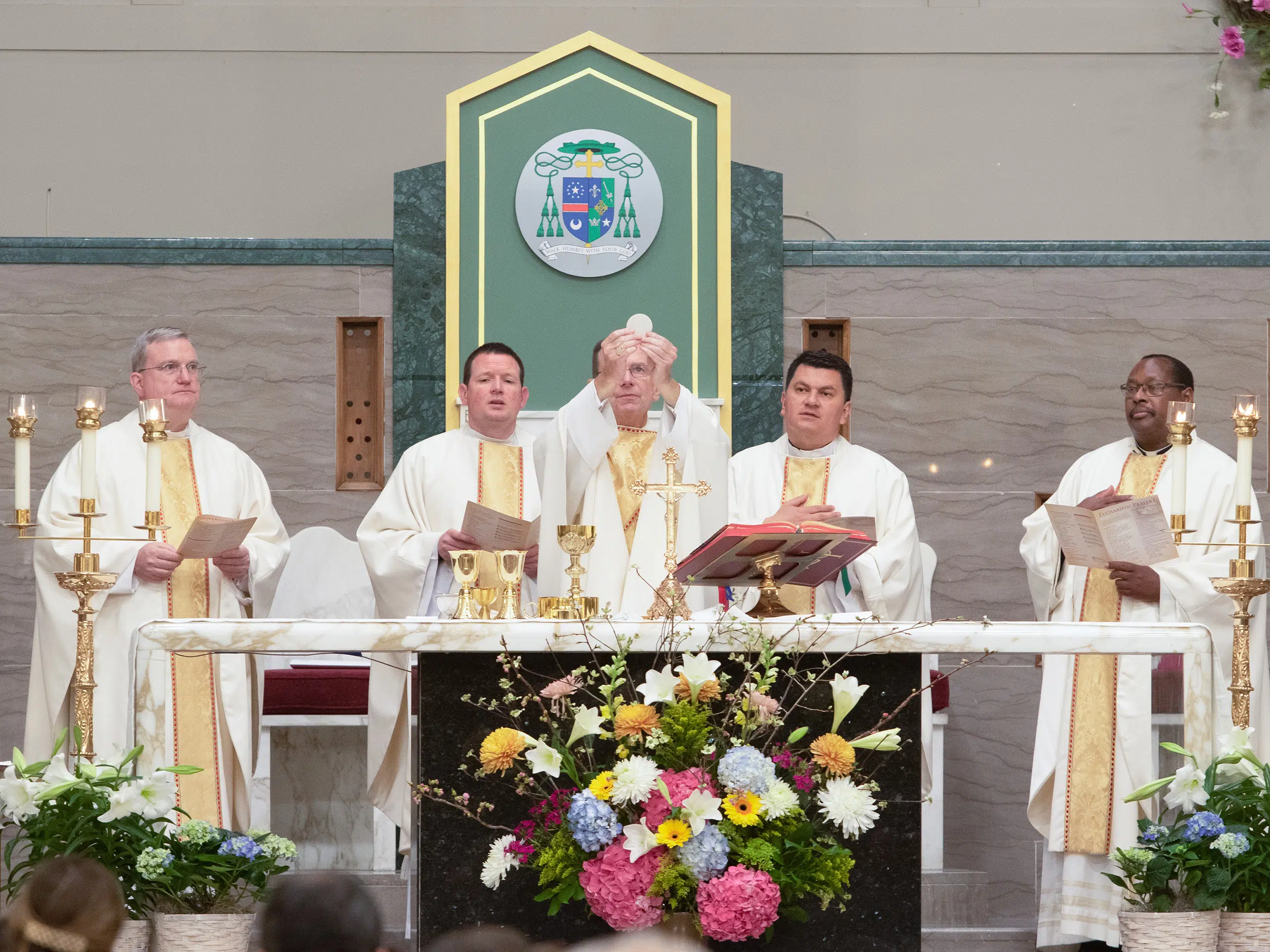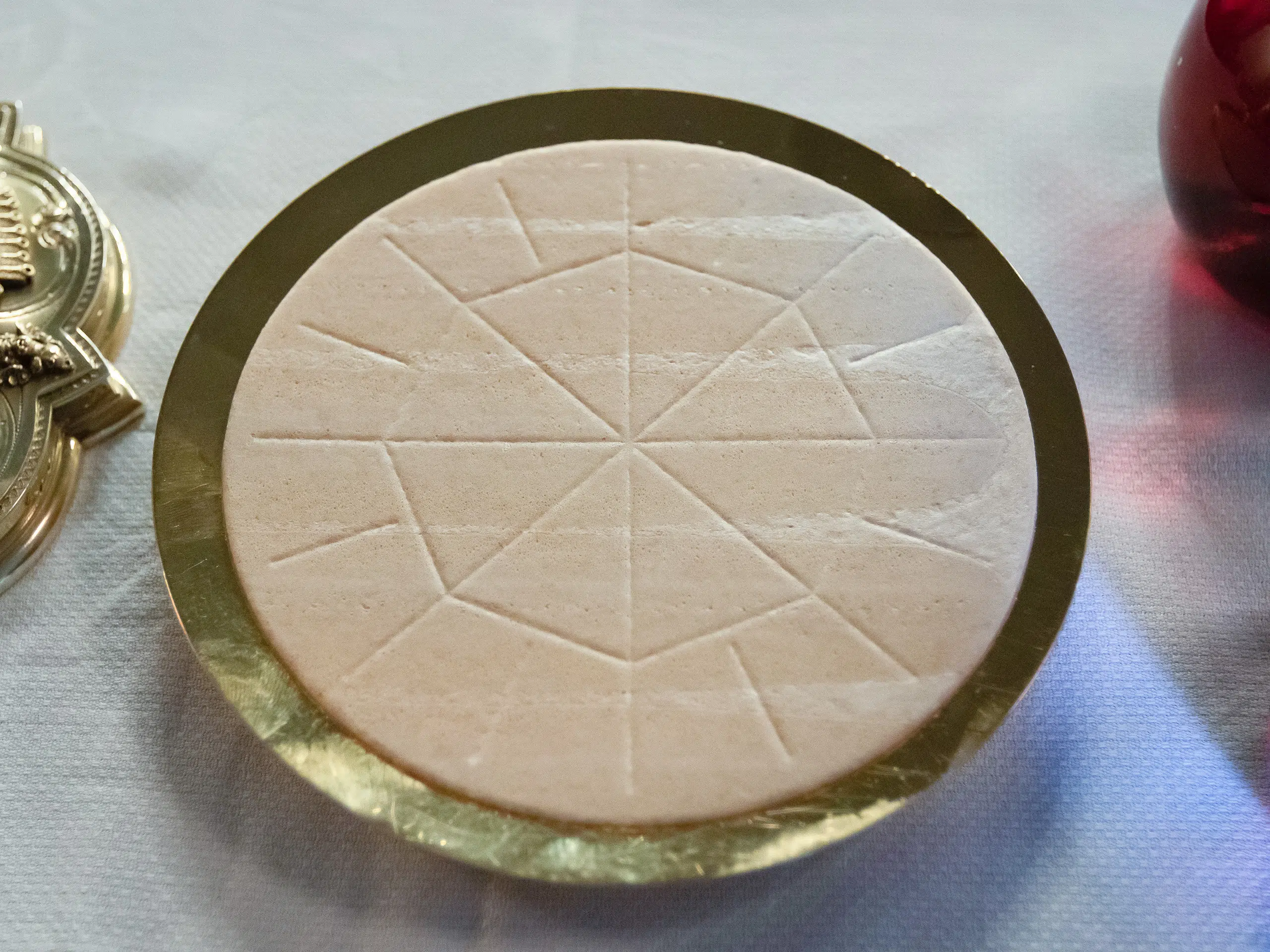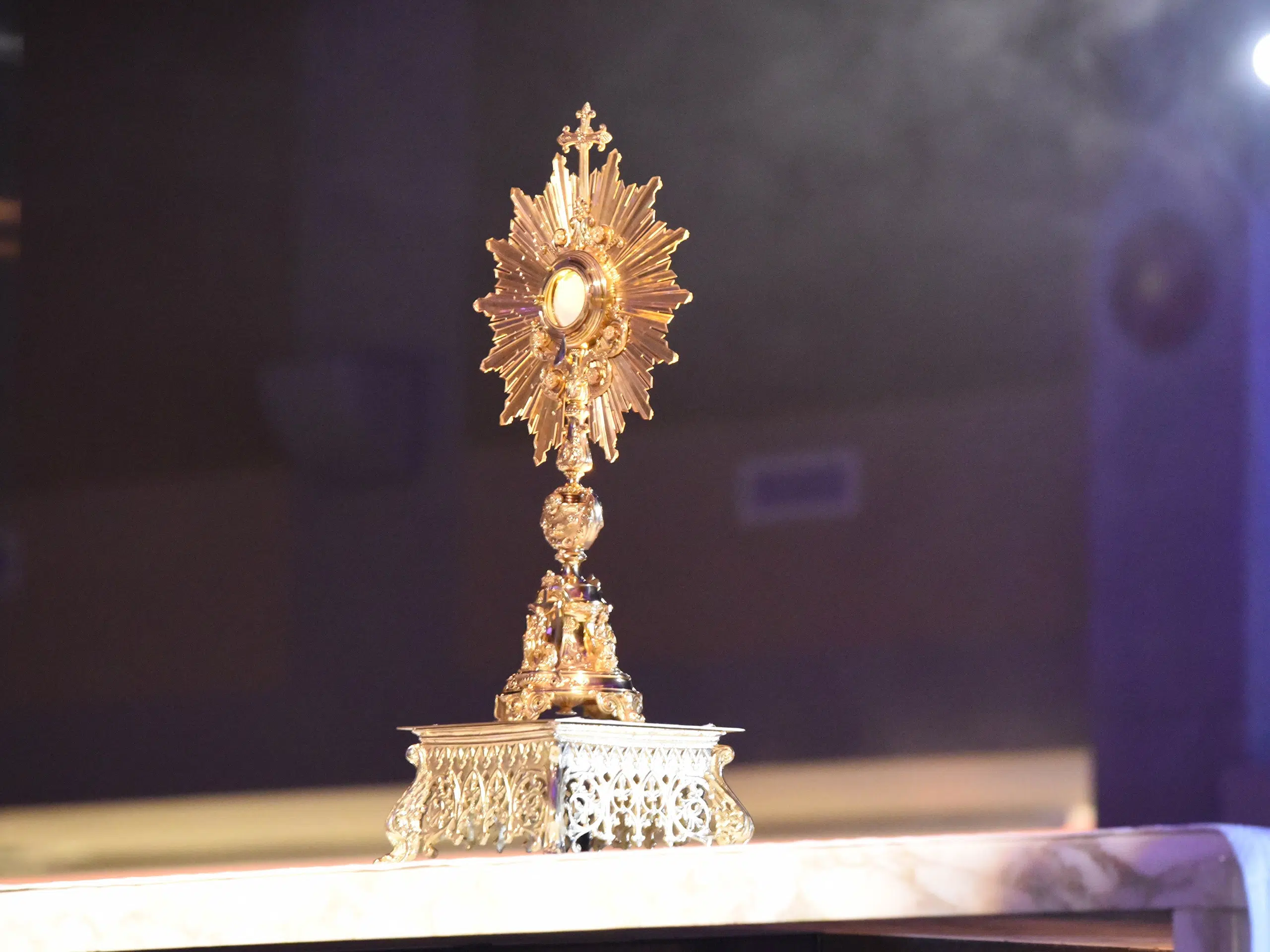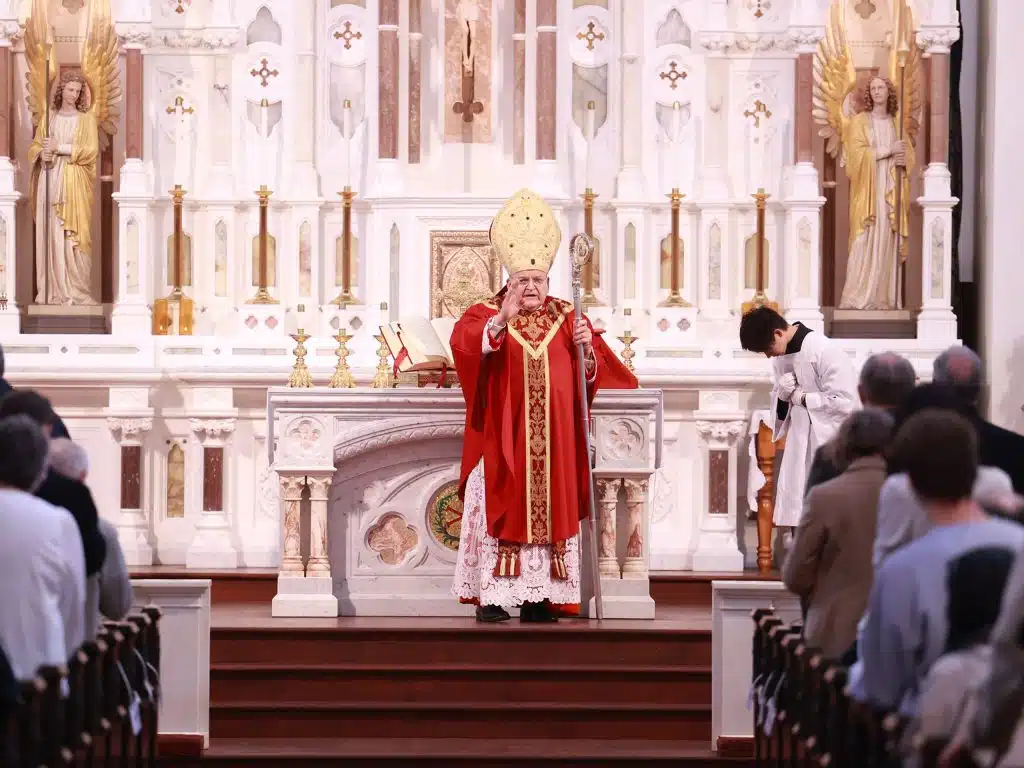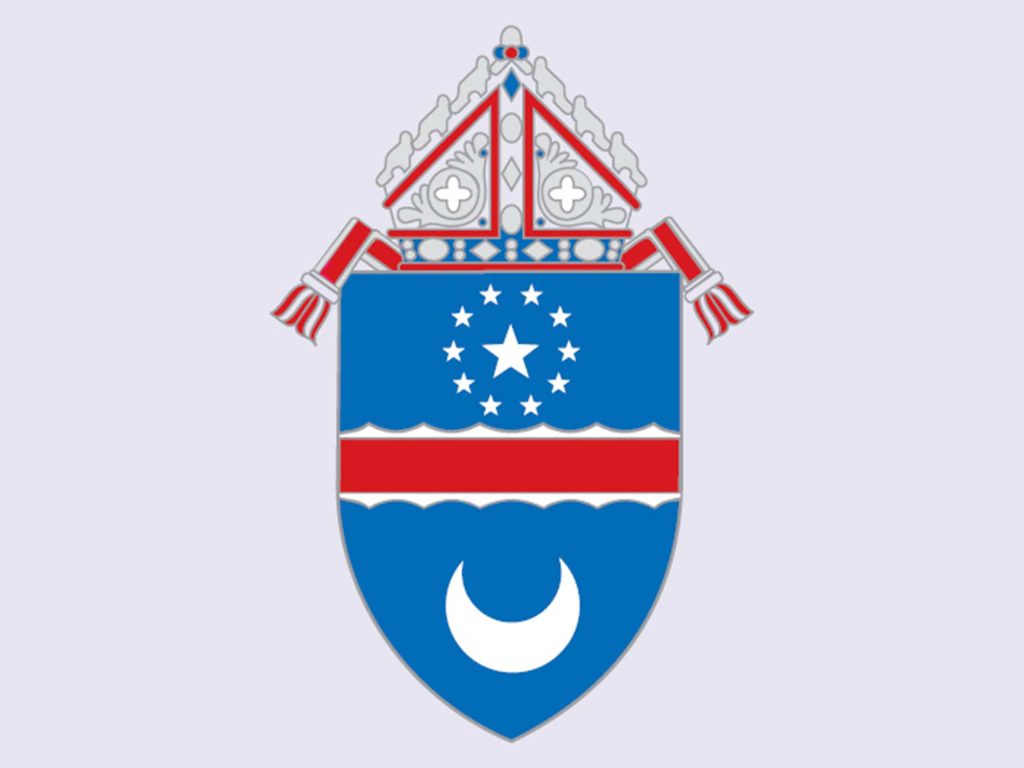The Catechism of the Catholic Church calls the Eucharist “the source and summit of the Christian life.” The Arlington diocese, in preparation for its 50th anniversary, is marking this year with the theme “Remember,” reflecting on the Eucharist and Christ’s words during the Last Supper: “Do this in remembrance of me.” The U.S. Conference of Catholic Bishops recently launched a multiyear Eucharistic revival.
Learn more about the Eucharist through church documents and the expertise of Matthew Tsakanikas, a theology professor at Christendom College in Front Royal.
How does the host and wine become Christ’s body and blood?
Section 1412 of the catechism says that wheat bread and grape wine become the Eucharist when the blessing of the Holy Spirit is invoked and the priest pronounces the words of consecration spoken by Jesus during the Last Supper: “This is my body which will be given up for you. This is the cup of my blood.”
What is transubstantiation?
In the 1500s, the Council of Trent declared, “Because Christ our Redeemer said that it was truly his body that he was offering under the species of bread, it has always been the conviction of the Church of God that by the consecration of the bread and wine there takes place a change of the whole substance of the bread into the substance of the body of Christ our Lord and of the whole substance of the wine into the substance of his blood. This change the holy Catholic Church has fittingly and properly called transubstantiation.”
Centuries before in 1215, the Fourth Lateran Council had affirmed this teaching.
Why isn’t the Precious Blood usually offered to Massgoers?
Since Christ is fully present in both the consecrated bread and wine, those who receive only the host receive all the fruit of Eucharistic grace, according to section 1390 of the catechism. This is the most common way of receiving Communion in the Latin rite, or Roman Catholic Church. Eastern rite Catholics usually receive Communion under both species, bread and wine.
Why do we have adoration?
During adoration, a consecrated host is placed in a monstrance, or a sacred vessel made of gold or silver, on the altar for people to see while they pray.
In the time of the Old Testament, God was physically present to the Israelites in the Holy of Holies, which held the Ark of the Covenant. It was a visible presence of a God who wished to share his life with humans, said Tsakanikas. “God’s unique presence was at the temple at Jerusalem,” he said.
Echoing that earlier tradition, the church teaches today that Christ continues to dwell on Earth in the Eucharist and many desire to adore Christ while in physical proximity to him. “To be near to God’s special presence is to be in a special proximity to a source that sends forth peace and grace and true spiritual life,” said Tsakanikas.
St. Paul VI said, “To visit the Blessed Sacrament is a proof of gratitude, an expression of love and a duty of adoration toward Christ our Lord.”
Can non-Catholic Christians receive Communion?
Catholics believe receiving Communion signifies that the recipient affirms the teachings of the church.
According to section 1400 of the catechism, “Ecclesial communities derived from the Reformation and separated from the Catholic Church (also known as Protestant churches), ‘have not preserved the proper reality of the Eucharistic mystery in its fullness, especially because of the absence of the sacrament of Holy Orders.’ It is for this reason that, for the Catholic Church, Eucharistic intercommunion with these communities is not possible. However these ecclesial communities, ‘when they commemorate the Lord’s death and resurrection in the Holy Supper … profess that it signifies life in communion with Christ and await his coming in glory.’ ”
However, Orthodox churches do “possess true sacraments,” and therefore their members can be admitted to Communion at Roman Catholic churches).
Why do we use unleavened bread for Communion in the Roman Catholic Church and leavened bread in Eastern Churches?
Christ instituted the Eucharistic sacrifice during Passover, sometimes called the Feast of Unleavened Bread. The bread he broke at the Last Supper was unleavened bread and the tradition of using unleavened bread during Mass continued. However, at one point, the church began to use leavened bread, or bread that had risen, to highlight the resurrection of Christ and to combat various heresies, said Tsakanikas.
“To be brief, and a bit over-simplified, the East continued the practice of leavened bread as a sign of discontinuity with Judaism and in favor of symbols of the resurrection. The West continued to emphasize that which was in continuity with Judaism’s ritual works and prefigurements,” he said. “Thus, there are different emphases in the Eastern and Western liturgies, which complement one another and preserve all memories and emphases of the church.”
What is unconsecrated Communion made of?
Catholics use grape wine and wheat bread for Communion. “Christ chose that matter and so the church doesn’t feel it has the authority to make it change when it comes to the sign that was chosen in the sacrament,” said Tsakanikas.
In 2017, the Vatican clarified that “the bread (for Roman Catholics) must be unleavened, purely of wheat, and recently made so that there is no danger of decomposition. The wine must be natural, from the fruit of the grape, pure and incorrupt, not mixed with other substances.”
Low-gluten hosts are permitted, but no-gluten hosts are not. “Hosts that are completely gluten-free are invalid matter for the celebration of the Eucharist. Low-gluten hosts (partially gluten-free) are valid matter, provided they contain a sufficient amount of gluten to obtain the confection of bread without the addition of foreign materials and without the use of procedures that would alter the nature of bread.”
How should Catholics prepare to receive Communion?
The catechism says people should prepare body and soul for a worthy reception of the Eucharist. One’s demeanor and clothes should convey respect, solemnity and the joy of the moment. Anyone receiving Communion should fast at least an hour from food and drink, except for water and medicine.
Anyone who is conscious of having committed a grave sin should receive the sacrament of reconciliation before coming to Communion. St. Paul says in 1 Corinthians 11:27-28, “Therefore, whoever eats the bread or drinks the cup of the Lord unworthily will have to answer for the body and blood of the Lord. A person should examine himself, and so eat the bread and drink the cup.”
During Mass, a full and active participation in the liturgy is the best way to prepare for receiving holy Communion, said Tsakanikas.
Where do parishes buy hosts and wine?
Many parishes in the Arlington diocese buy hosts and wine from Peter C. Munley Church Goods store in Vienna. Pete Munley, a Catholic from Pennsylvania, is the owner of the business his grandfather started. He sources the hosts from Cavanagh Altar Bread in Greenville, R.I. Parishes can choose white or whole wheat bread, the size of the host and whether it is imprinted with a religious symbol, such as a cross or a lamb. “The average church would go through 16,000 hosts every month pre-COVID,” he said.
The wine comes from Mont La Salle Altar Wines in Napa, Calif., though wine sales have gone down since COVID. “I sell almost as much white as I do red,” said Munley. “Certain types of wine are 18 (percent alcohol) and certain types are 12, for example Angelica on the white side, that’s an 18. I still do Rosé, that’s the most popular on the red and that happens to be a 12.”
On the Eucharist
“I am the living bread that came down from heaven; if any one eats of this bread, he will live forever; …he who eats my flesh and drinks my blood has eternal life and … abides in me, and I in him.” John 6:51, 54, 56.
“If angels could be jealous of men, they would be so for one reason: Holy Communion.” St. Maximilian Kolbe
“The greatest love story of all time is contained in a tiny white host.” Archbishop Fulton Sheen
“Out of the darkness of my life, so much frustrated, I put before you the one great thing to love on earth: the Blessed Sacrament … There you will find romance, glory, honour, fidelity, and the true way of all your loves upon earth.” J.R.R. Tolkien
“The substantial conversion of bread and wine into his body and blood introduces within creation the principle of a radical change … which penetrates to the heart of all being, a change meant to set off a process which transforms reality, a process leading ultimately to the transfiguration of the entire world, to the point where God will be all in all.” Sacramentum Caritatis, Benedict XVI
“Godhead here in hiding, whom I do adore
Masked by these bare shadows, shape and nothing more,
See, Lord, at thy service low lies here a heart
Lost, all lost in wonder at the God thou art.
Seeing, touching, tasting are in thee deceived;
How says trusty hearing? that shall be believed;
What God’s Son has told me, take for truth I do;
Truth himself speaks truly or there’s nothing true.” St. Thomas Aquinas
“Receive the Body and Blood of the Lord so that he may transform your frailties, fill you with his love and peace and nourish you to bear witness to him in the world and live always as a holy family.” Bishop Michael F. Burbidge
“To preside at Eucharist is to be plunged into the furnace of God’s love.” Desiderio Desideravi, Pope Francis
Prayer after receiving Communion: Anima Christi
Soul of Christ, sanctify me.
Body of Christ, save me.
Blood of Christ, inebriate me.
Water from the side of Christ, wash me.
Passion of Christ, strengthen me.
O good Jesus, hear me.
Within your wounds conceal me.
Do not permit me to be parted from you.
From the evil foe protect me.
At the hour of my death call me.
And bid me come to you,
to praise you with all your saints
for ever and ever.
Amen.
En ego, o bone et dulcissime Iesu
Here,
O good and gentle Jesus,
I kneel before you,
and with all the fervor of my soul
I pray that you engrave within my heart
lively sentiments of faith, hope, and love,
true repentance for my sins,
and a firm purpose of amendment.
While I see and I ponder your five wounds
with great affection and sorrow in my soul,
I have before my eyes those words of yours
that David prophesied about you:
“They have pierced my hands and feet;
I can count all my bones.” (Ps 22, 17)
Amen.
Source: U.S. Conference of Catholic Bishops
To download The Eucharist explained click here.
